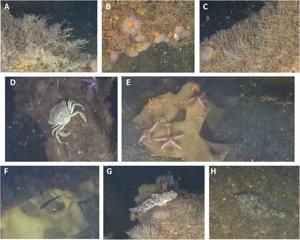World
Marine Life Thrives on WWII Explosives in the Baltic Sea

Scientists have discovered that marine life, including crabs, worms, and fish, is thriving on the surfaces of World War II explosives in the Baltic Sea. This finding emerged from an expedition using an undersea submersible at a former weapons dump site, where researchers observed more creatures inhabiting the warheads than the surrounding seabed. According to study author Andrey Vedenin from the Senckenberg Research Institute in Germany, initial expectations predicted lower populations due to the presumed toxicity of these remnants. Instead, the results revealed a surprising abundance of marine organisms.
The Baltic Sea is home to approximately 1.6 million tons (1.5 million metric tonnes) of dumped munitions, primarily from the two world wars of the 20th century. These relics often contain nuclear and chemical remnants alongside explosives such as TNT. This latest research adds to a growing body of evidence showing that wildlife can flourish in polluted environments. Past studies have documented shipwrecks and former military sites serving as vibrant ecosystems.
Unexpected Biodiversity on Warheads
In the current study, researchers filmed diverse marine networks, including anemones and starfish, in the Bay of Lübeck off Germany’s coast, using fragments of V-1 flying bombs as a backdrop. James Porter, an ecologist from the University of Georgia not involved in the research, remarked, “Normally, one does not study the ecology of bombs.”
The intriguing question arises: why do sea creatures choose to inhabit these contaminated weapons? According to Vedenin, the hard surfaces of the explosives may provide an appealing habitat, particularly in the Baltic Sea, where the seabed predominantly consists of flat mud and sand. The removal of stones and boulders for construction during the 1800s and 1900s has left few natural hard surfaces, making the warheads attractive to marine life.
Moreover, the area surrounding the explosives tends to be relatively isolated from human activity due to the presence of chemicals, which creates a unique environment where marine life can thrive despite the potential hazards.
Future Research Directions
Scientists are now looking to quantify how much contamination these sea creatures have absorbed. An important next step in the research will involve observing whether these organisms can reproduce in their unusual habitat.
Marine conservation biologist David Johnston from Duke University emphasized the significance of these findings, stating that studies like this highlight nature’s ability to adapt and flourish in the wake of human activities. Johnston has previously mapped sunken World War I ships that have similarly become habitats for wildlife along the Potomac River in Maryland. “I think it’s a really cool testimony to the strength of life,” he said.
This research was published on October 12, 2023, in the journal Communications Earth and Environment. The findings underscore a complex relationship between humanity and the natural world, illustrating how life can not only persist but thrive in environments shaped by historical conflicts.
-

 Science3 months ago
Science3 months agoToyoake City Proposes Daily Two-Hour Smartphone Use Limit
-

 Top Stories3 months ago
Top Stories3 months agoPedestrian Fatally Injured in Esquimalt Collision on August 14
-

 Health3 months ago
Health3 months agoB.C. Review Reveals Urgent Need for Rare-Disease Drug Reforms
-

 Technology3 months ago
Technology3 months agoDark Adventure Game “Bye Sweet Carole” Set for October Release
-

 World3 months ago
World3 months agoJimmy Lai’s Defense Challenges Charges Under National Security Law
-

 Lifestyle3 months ago
Lifestyle3 months agoVictoria’s Pop-Up Shop Shines Light on B.C.’s Wolf Cull
-

 Technology3 months ago
Technology3 months agoKonami Revives Iconic Metal Gear Solid Delta Ahead of Release
-

 Technology3 months ago
Technology3 months agoApple Expands Self-Service Repair Program to Canada
-

 Technology3 months ago
Technology3 months agoSnapmaker U1 Color 3D Printer Redefines Speed and Sustainability
-

 Technology3 months ago
Technology3 months agoAION Folding Knife: Redefining EDC Design with Premium Materials
-

 Technology3 months ago
Technology3 months agoSolve Today’s Wordle Challenge: Hints and Answer for August 19
-

 Business3 months ago
Business3 months agoGordon Murray Automotive Unveils S1 LM and Le Mans GTR at Monterey









